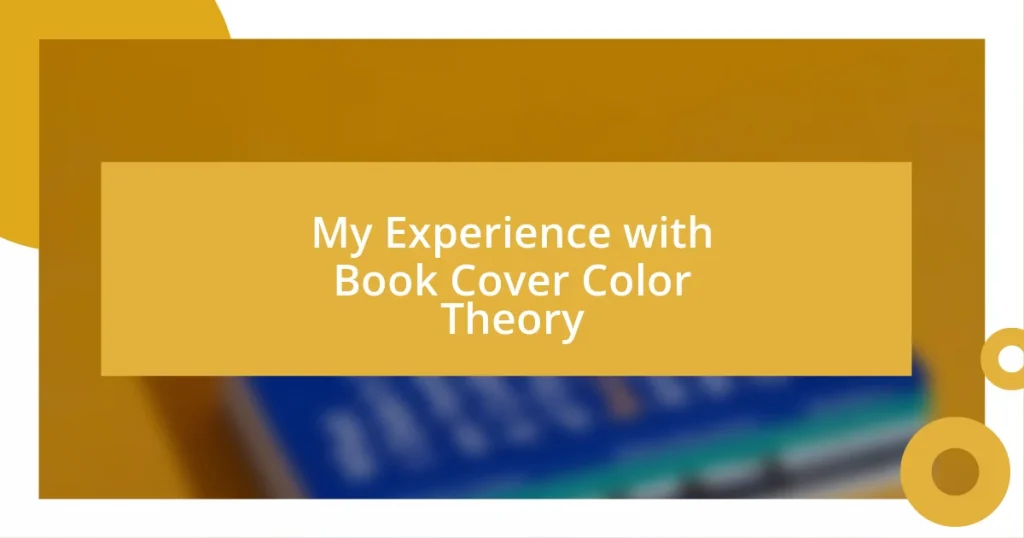Key takeaways:
- Color theory significantly influences emotional responses to book covers, with specific colors evoking different feelings and setting genre expectations.
- Creating contrast in cover design enhances visual impact and can effectively communicate mood and tone to potential readers.
- Balancing color with typography is crucial for readability and conveying the appropriate message, making it essential for cover designs to resonate with the audience.

Understanding Color Theory Basics
Color theory is like a secret language that guides our emotional responses to visual art, especially book covers. I vividly remember the first time I picked up a book with a dark blue cover; it drew me in instantly, evoking feelings of calm and mystery. Have you ever paused to consider how the colors on a cover might influence your mood as you browse a bookstore?
At its core, color theory explores the relationships between colors and how they can convey meaning. For instance, red often symbolizes passion or excitement, while green can represent growth or tranquility. When I designed my own book cover, I spent hours choosing the perfect shades. Do you think I overanalyzed the color choices? Maybe, but I truly believe that the right colors can elevate a reader’s anticipation even before they turn the first page.
Understanding the basics of color theory can also enhance how you connect with your audience. Imagine creating a cover that harmonizes with the book’s theme—using monochromatic colors for a serious topic versus a vibrant palette for something lighthearted. The emotional impact is significant. Have you experienced that moment when a cover perfectly reflects the story within? It’s like a visual hug that invites readers in.

Psychological Effects of Color Choices
The colors we choose for a book cover can evoke profound psychological responses that resonate deeply with potential readers. For instance, I remember designing a cover for a thriller. I opted for dark, intense shades that not only conveyed suspense but also created an atmosphere of intrigue. This decision was based on my understanding that darker colors can elicit feelings of anxiety, making it more appealing to fans of the genre.
Here are some key psychological effects associated with specific color choices:
- Red: Energizing and associated with strong emotions like love and anger; it can incite excitement or even aggression.
- Blue: Calming and serene; it’s often linked to trust and stability, making it ideal for non-fiction or self-help genres.
- Yellow: Bright and cheerful; it evokes feelings of happiness and optimism, often used for children’s books or light-hearted stories.
- Green: Symbolizes nature and growth; it has a restful effect and often appeals to themes of renewal or tranquility.
- Black: Represents sophistication and elegance, frequently used in high-end or mysterious genres.
Reflecting on my own experiences, I often notice how a simple color choice can make me stop in my tracks at a bookstore. Just the other day, I spotted a book with a vibrant orange cover that radiated energy and creativity, instantly sparking my interest. Colors can tell a story long before a reader opens a book, and that’s the beauty of understanding their psychological impact.

Choosing Colors for Genre Representation
Choosing the right colors for genre representation is essential for capturing the essence of a book. I recall the time I chose a deep red and black color scheme for a horror novel cover. The moment I saw it, I felt a rush of excitement mixed with a twinge of fear, exactly the kind of reaction I hoped to inspire in potential readers. It’s fascinating how certain colors can instantly communicate a genre’s mood without the need for words.
To illustrate the relationship between colors and genres, I experimented with various palettes for different themes. For romance, softer pastels like pinks and lavenders worked wonders, evoking warmth and tenderness. On the other hand, when I worked on a science fiction cover, cool hues like silver and blue suggested a futuristic vibe, reinforcing the theme while attracting the right audience. Did you ever notice how specific colors can feel like they belong to their respective genres?
The combination of colors can create a powerful narrative on its own. When designing a fantasy novel cover, I selected rich greens and golds to evoke a sense of adventure and magic. It resonated with me deeply; the colors sparked my imagination, transporting me to far-off lands before I even cracked open the book. But have you found that covering a genre authentically is less about trends and more about genuine connections? It certainly is for me.
| Genre | Common Color Choices |
|---|---|
| Romance | Pastels, Reds, Pinks |
| Thriller | Dark Blues, Blacks, Reds |
| Fantasy | Greens, Golds, Purples |
| Science Fiction | Silvers, Blues, Grays |
| Children’s Books | Bright Primaries, Yellows, Oranges |

Creating Contrast and Visual Impact
Creating contrast in book cover design is like composing a visual symphony. I distinctly remember a project where I juxtaposed a bright yellow against a deep blue for a motivational book. That bold choice didn’t just attract attention; it created a striking dynamic that spoke to the reader’s aspirations and dreams. Have you ever seen a contrast so strong that it almost jumps off the shelf? I certainly have, and it’s captivating.
Each color carries weight, and when combined successfully, they can amplify the message you’re trying to convey. I once experimented with a black background paired with a vibrant red title for a suspense novel. The stark contrast immediately instilled a sense of urgency and tension. Readers want to feel something when they look at a cover; that powerful visual interplay can spark curiosity in ways words sometimes can’t.
When considering contrast, I always keep the target audience in mind. For instance, while designing a children’s book, I used a palette of bright pinks and greens, layered in ways that played off each other and created a sense of playfulness. Walking through a bookstore, I noticed how children naturally gravitate toward covers that pop and excite them. Isn’t it fascinating how the right contrast not only forms an eye-catching design but also communicates mood and tone effortlessly?

Balancing Color with Typography
Balancing color with typography is an art that requires careful thought and an understanding of how these elements interact. One time, while designing a cover for a historical fiction novel, I chose a warm beige for the background which allowed the classic serif font in dark brown to stand out beautifully. That subtle contrast created an inviting yet sophisticated feel that matched the book’s tone perfectly, don’t you think it’s essential for the typography to convey the same mood as the colors?
I’ve learned that the right font can elevate color choices to a new level. When I was working on a cover for a modern thriller, I used a sleek, sans-serif font in white over a dramatic red backdrop. This sharp contrast not only drew attention but also conveyed urgency and clarity. Have you ever felt that a well-designed title practically pulses with excitement? That’s the magic of combining color with typography.
In my experience, readability plays a crucial role in this balance. During one project, I experimented with a bold, brush script font against a deep navy background, but it just didn’t work. The text got lost amidst the colors, causing frustration rather than intrigue. It reminded me of the importance of ensuring that your design is not only visually striking but also easily legible. How frustrating is it to see a beautiful cover where the title is hard to read? Good typography should sing along with the colors, not drown in them.

Testing Color Effectiveness with Audiences
Testing color effectiveness with audiences is a fascinating experience that goes beyond mere visuals. I once held a small focus group for a fantasy novel cover I designed with a vibrant purple and gold color scheme. The reactions were mixed—while some felt it conveyed magic and adventure, others thought it looked too extravagant. Isn’t it intriguing how subjective color perception can be?
I remember a time when I decided to survey potential readers on a cover that featured a soft pastel palette. The feedback was revealing; those colors drew in a younger audience, who expressed feelings of serenity and approachability. This reinforced my belief that colors can evoke emotions and varied interpretations. Have you ever paused to consider how your favorite colors impact your mood?
To further test effectiveness, I’ve dabbled in A/B testing, comparing two different covers on social media. One featured bold, saturated hues, and the other had muted tones. The engagement rates told a clear story, favoring the brighter option, which sparked higher shares and comments. It made me ponder—what drives our choices? It seems color not only impacts initial attraction but also influences conversation and connection with readers.















